5 Crucial SEO Trends (and How to Adapt)
Written by Amanda Milligan

2025 provided the biggest SEO upheaval since the industry’s beginnings.
So while some fundamentals will always remain important, recent trends have never mattered more.
Not because they’re cool hacks, but because they reflect actual changes in the way people search and shop online.
In this post, I’ll show you the five SEO trends we’re prioritizing in 2026.
Each trend comes with examples and clear takeaways you can use right away.
Let’s start.
1. Third-Party Signals Are an SEO Priority
In the past, the primary third-party focus for SEOs has been link building.
Now links are part of a bigger story. (Arguably, they always have been, but I digress.)
With LLMs relying on a diversity of sources to compose their answers, companies are realizing very quickly that they need to be more present across the web in order to compete in AI-generated answers.
Take this ecommerce example from ChatGPT.
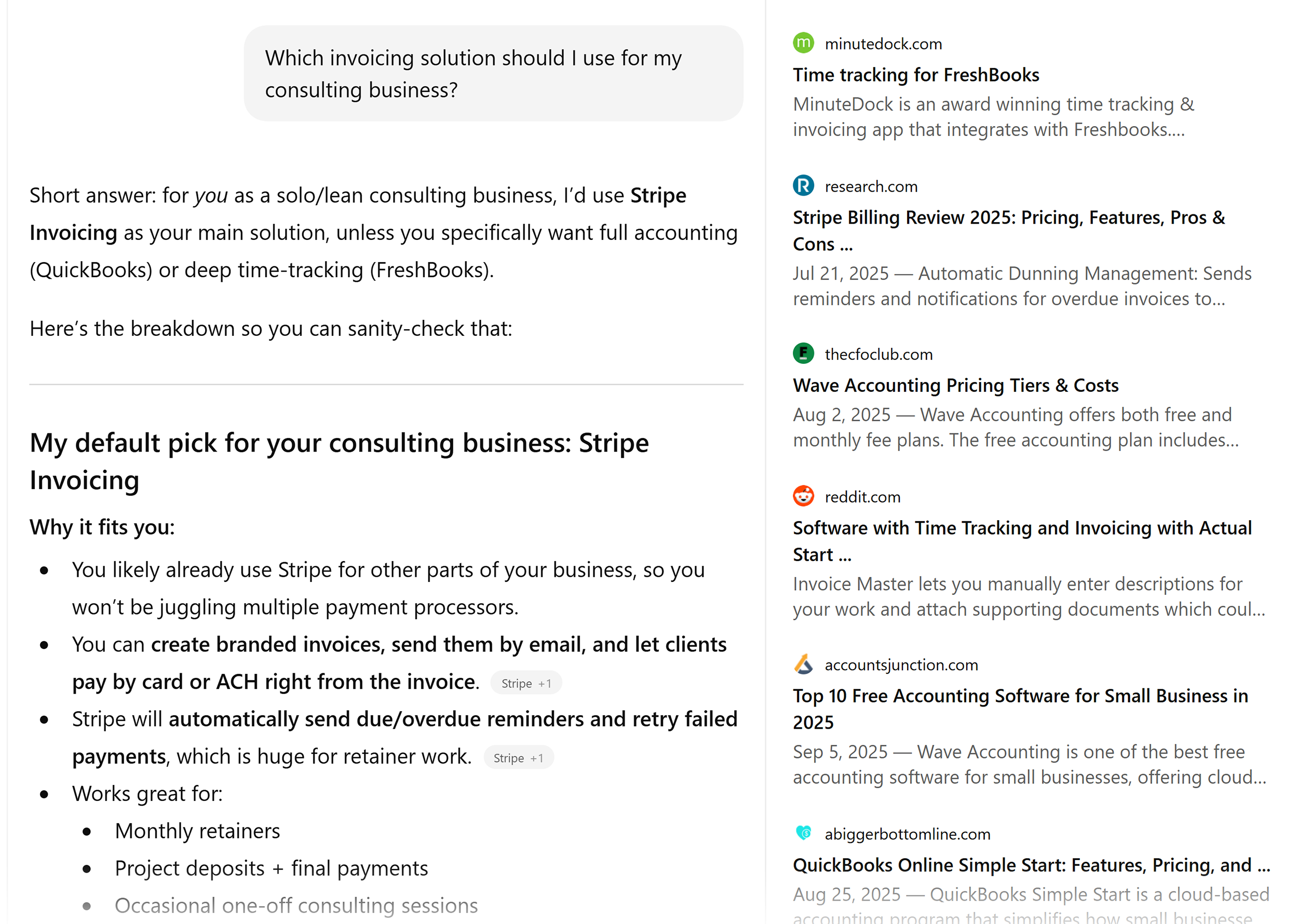
I asked about invoicing solutions, and ChatGPT pulled from 36 different sources. Many sites were the websites of their recommendations — Stripe, QuickBooks, etc. But others were third-party sites like research.com or community-based sites like Reddit.
This even happens with more branded queries.
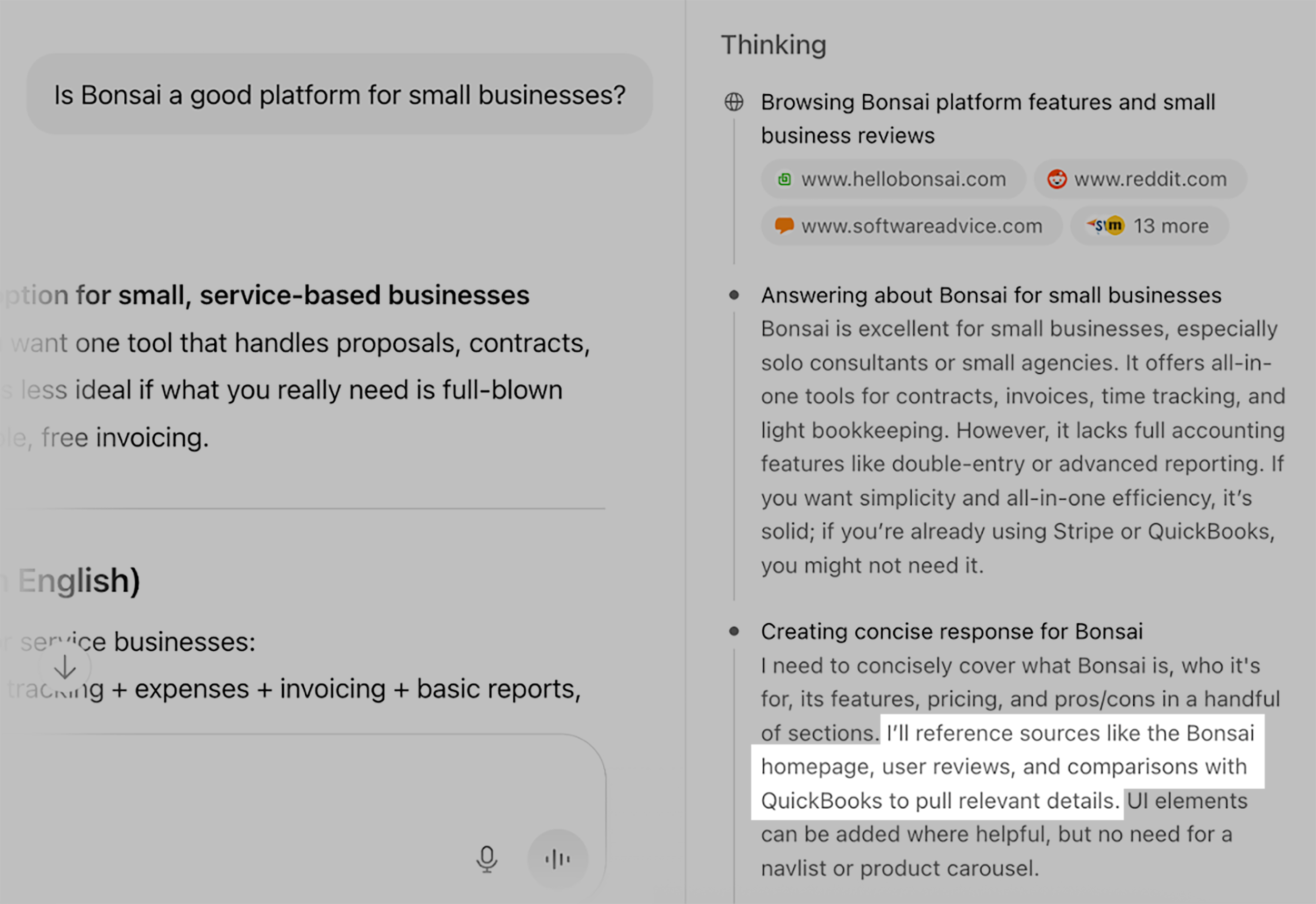
When I asked about the business hub Bonsai, ChatGPT thought for 23 seconds and pulled from 16 sources, many of which were third-party sites comparing Bonsai to QuickBooks.
So what does this all mean?
You need your homepage to have the critical information people are searching for, but you also need other websites to back up your claims.
How this changes your strategy: You need to perform prompt research to see where LLMs are pulling their information from when answering relevant queries. Then you need to develop a content and outreach plan for getting featured or mentioned on those sites.
2. Top-of-the-Funnel Content is Measured Differently
Top-of-the-funnel content (also called “awareness content”) used to be excellent for driving traffic to a site because the topics appealed to a wide audience.
However, AI Overviews started answering a lot of those queries right at the top of search results, making it unnecessary for searchers to click on a website (meaning significantly less traffic goes to sites).
For example, thousands of people every month search for “what is the difference between medicare and medicaid.
Anthem’s article on the topic ranks at the top of search, but above that, the answer is already provided via an AI Overview.
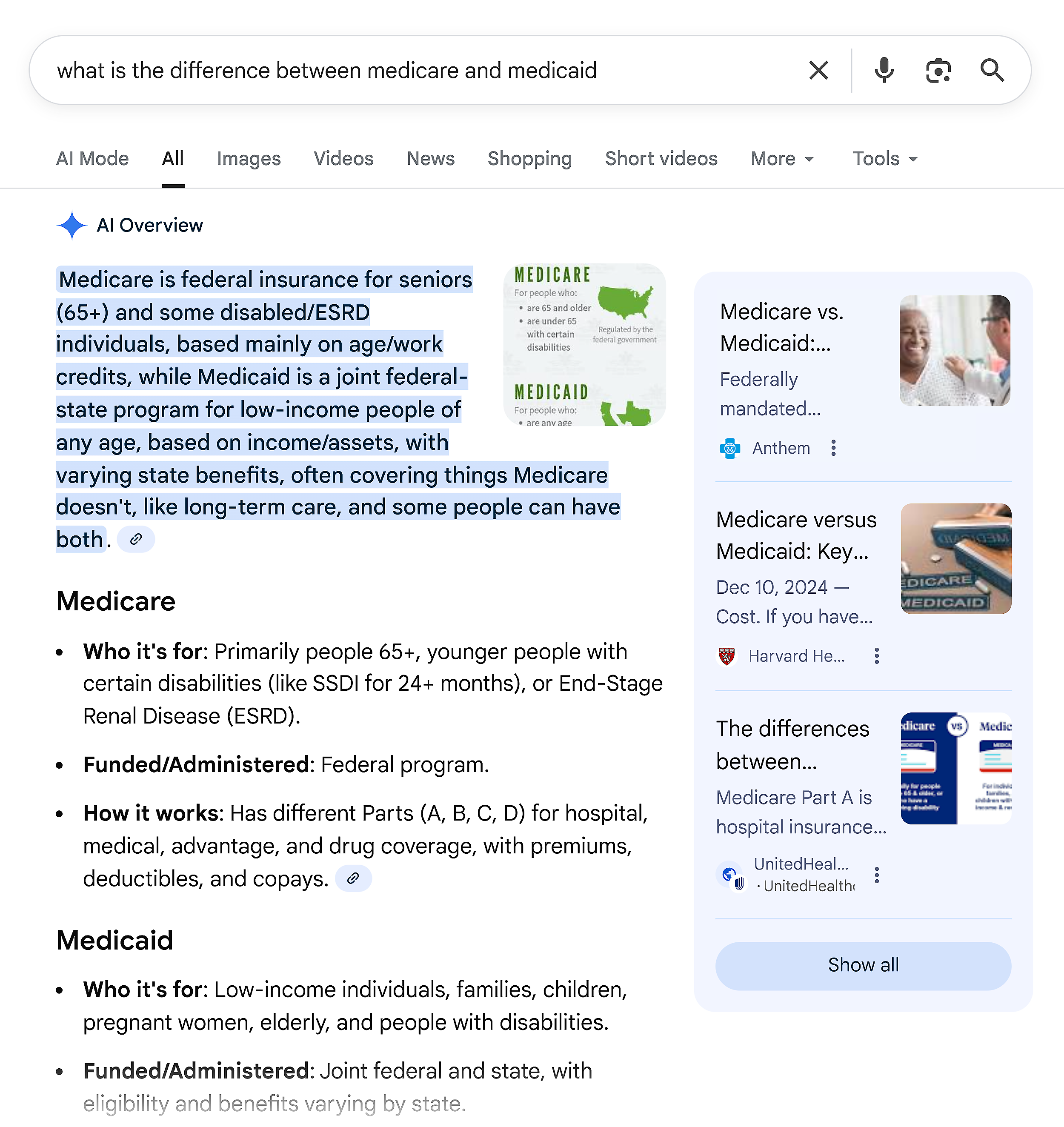
Upon seeing this shift in search, many marketers decided that top-of-the-funnel content isn’t worth it anymore.
But others see an opportunity to use it — and measure it — differently.
One shift in perspective is directly tied to our first trend: earning third-party authority signals.
Top-of-the-funnel content has traditionally been a great vehicle for earning backlinks. Stories that are widely relevant are more appealing to top publishers, since their audience is more likely to take an interest.
Take Gusto, which has an “Insights” section of the site where they post data-backed content. Their article about promotions being at an all-time low is of critical interest to the wider U.S. labor market.

This article alone got mentioned on authoritative publications like Business Insider and Fast Company.
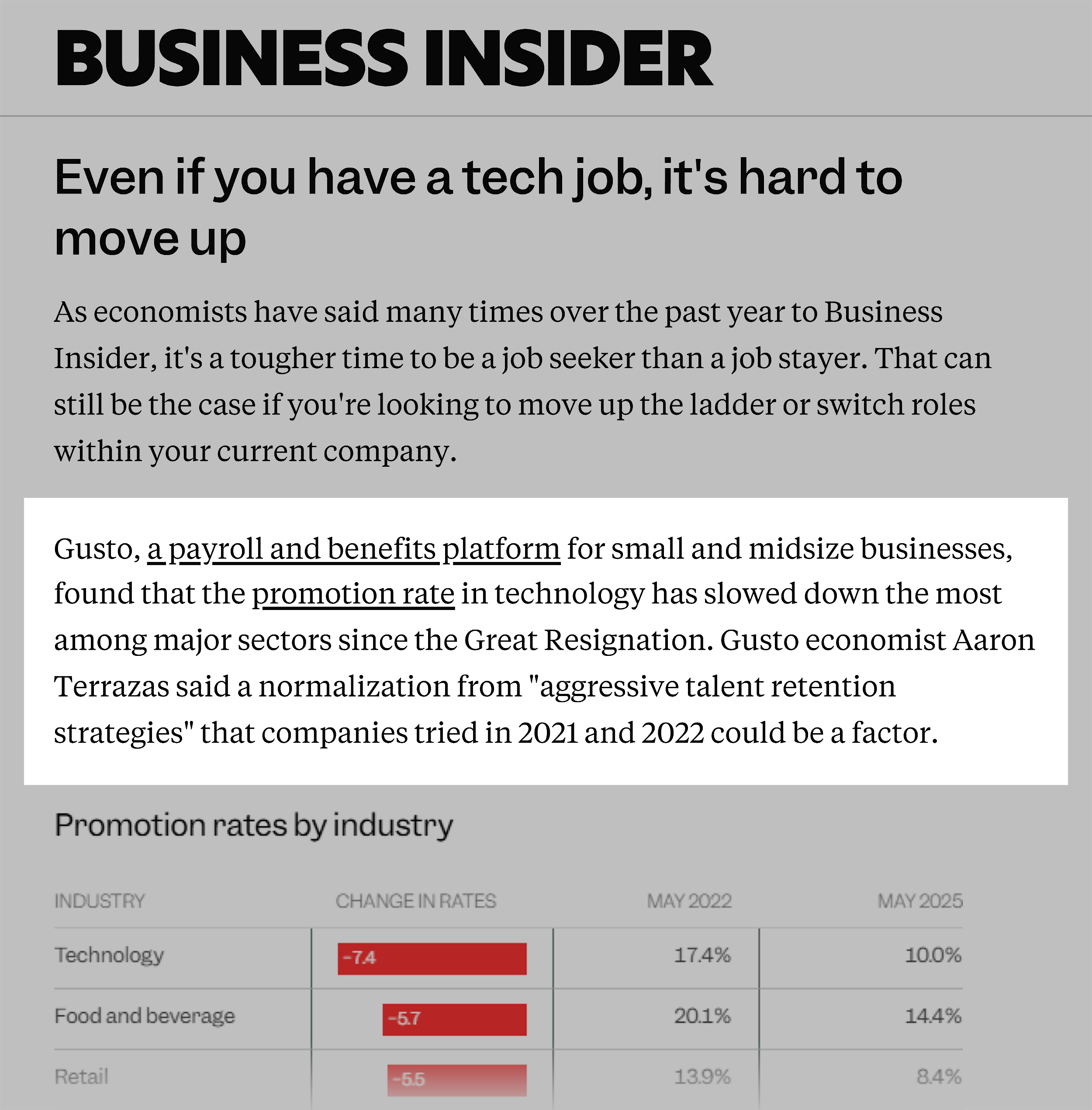
Not only does this validate that Gusto’s information is valid and interesting, but it also broadens their brand awareness to these publications’ audiences.
Another shift in perspective is considering how top-of-the-funnel content can fuel citations in LLMs.
Fintech company SoFi put together an article about gas prices by year and by state.
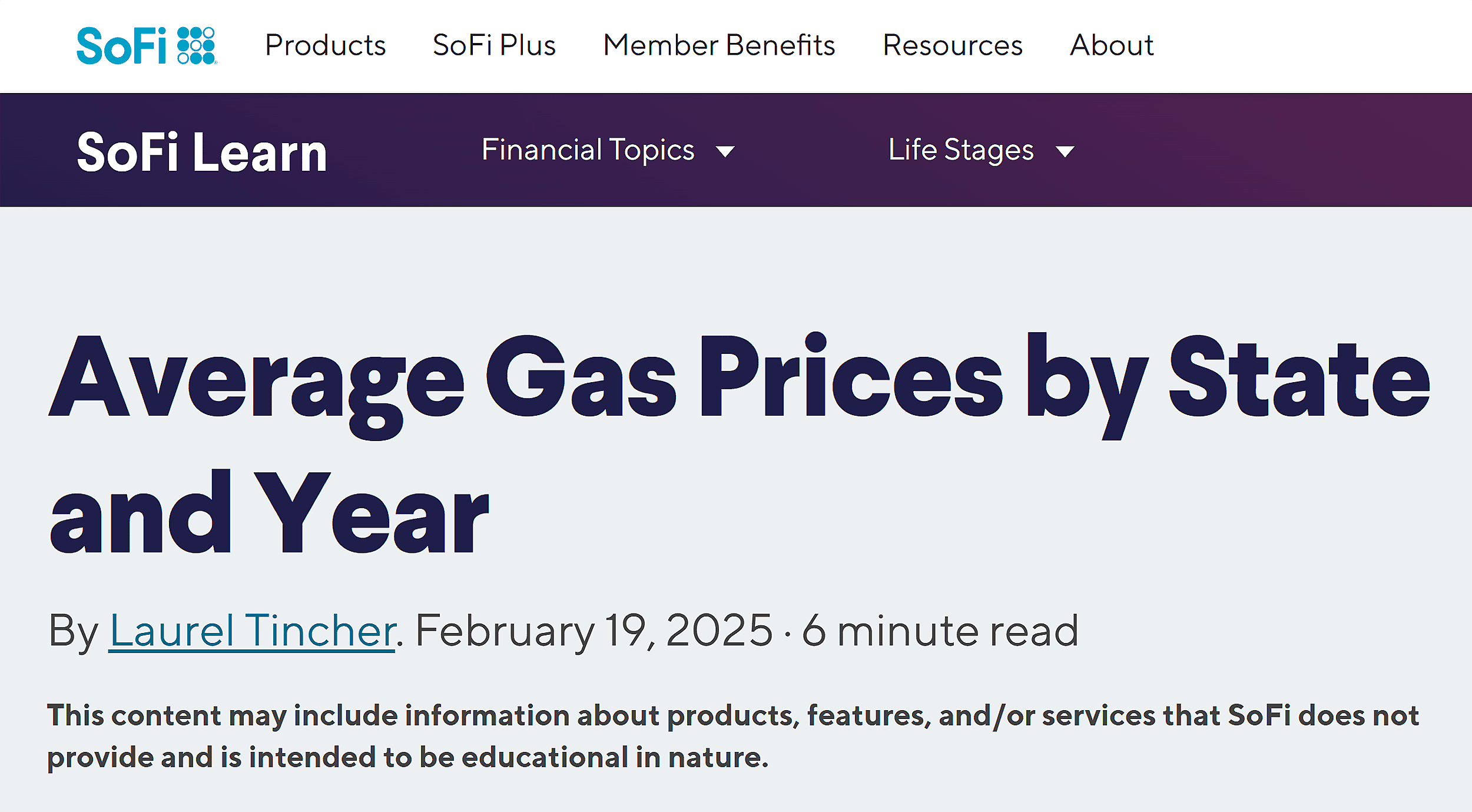
It doesn’t have top position in Google for “gas prices by state,” so by traffic-measurement standards, it would be disappointing.
But look at how it shows up in LLM answers for similar queries.
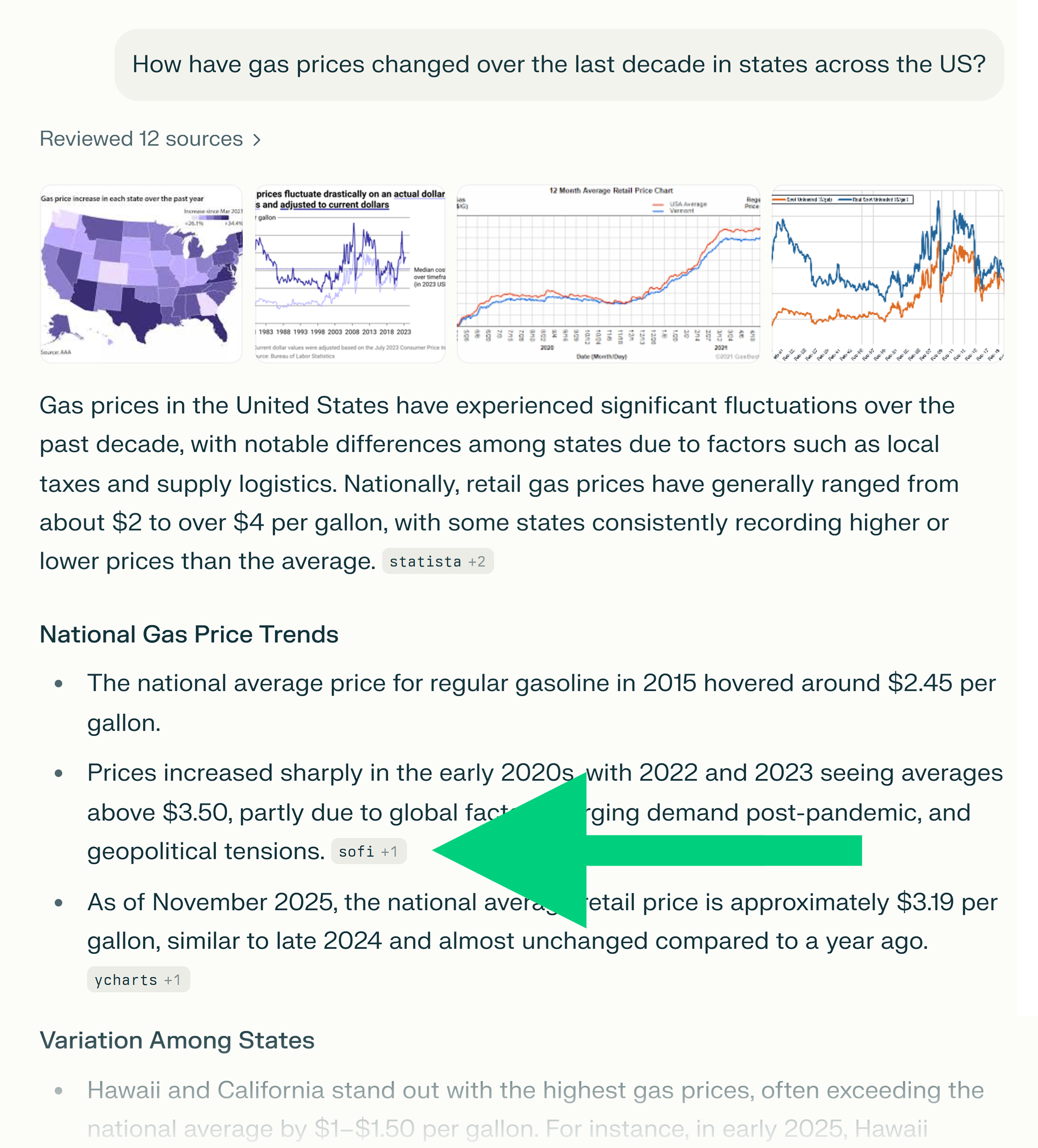
Consider what kind of data studies, surveys, and other new sources of information you can put together that are likely to generate third-party mentions or LLM citations. This approach will help build your brand’s credibility over time.
How this changes your strategy: Don’t think about top-of-the-funnel content in terms of search volume but in terms of newsworthiness. Is another site likely to mention your content because it’s highly relevant, timely, or impactful? These are the new barometers for whether you should create a higher-in-the-funnel piece.
3. Niche Content Is Worth the Investment
If top-of-the-funnel content is getting a new job, niche content is becoming the star of the show.
LLM prompts rarely look like classic head terms anymore.
Instead of “best invoicing software,” you see things like “simple invoicing tool for a solo graphic designer in Virginia who gets paid in EUR and USD” or “how should a small home services business structure invoices for one-off vs recurring jobs.”
Those answers are stitched together from very specific pieces of content. The model needs detailed pages, written for a clear use case, to build something that feels custom to the user.
This lines up with what people want in general. There’s so much content on every topic that broad advice starts to feel invisible. What stands out now is content that feels like, “This was written for someone exactly like me.”
For example, when I use Semrush’s AI Visibility Overview tools, and I see what prompts Backlinko is showing up in, I noticed this prompt about how people can apply the tips provided in our guides, specifically on their website.
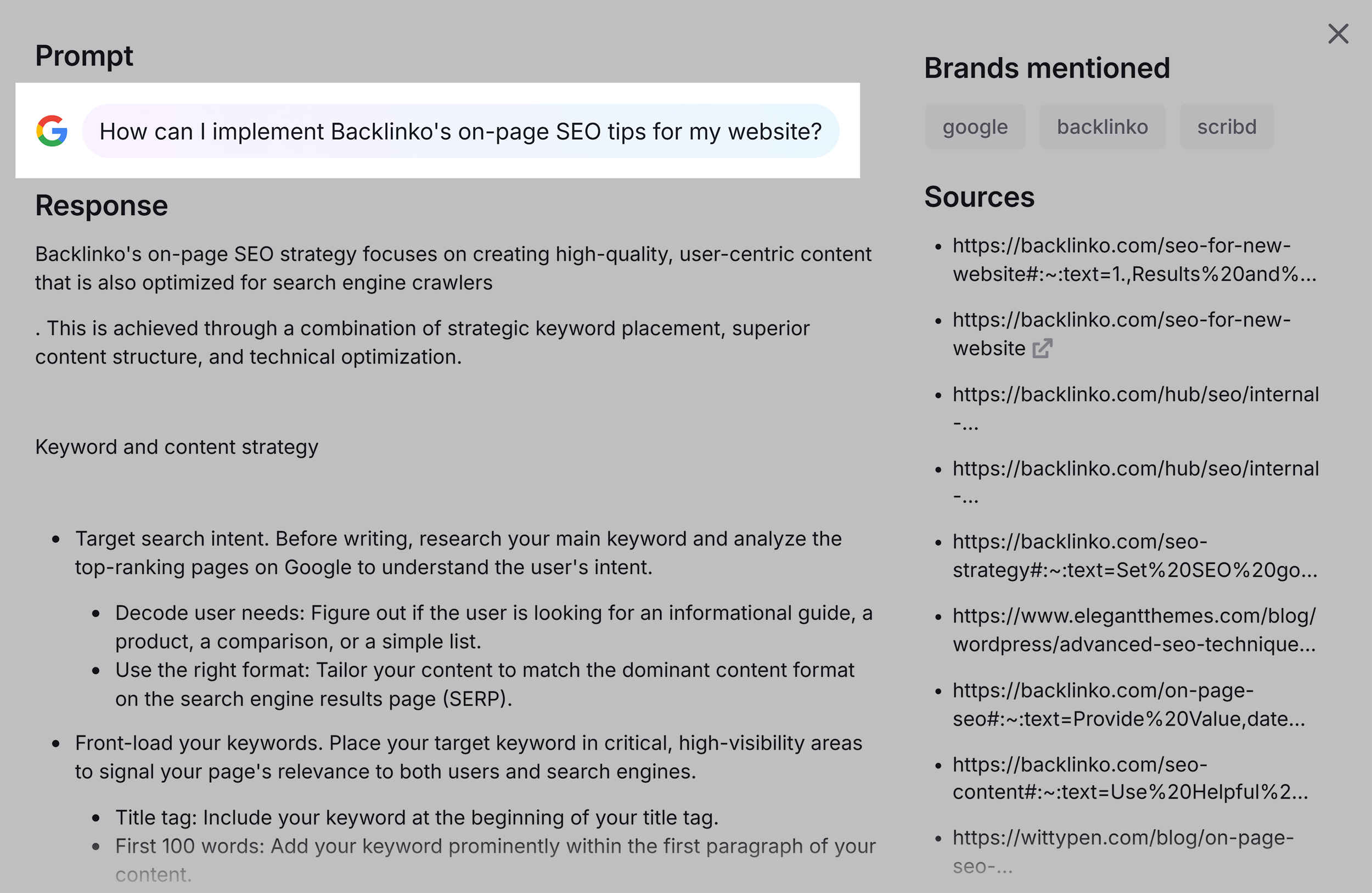
Not only can LLMs go into much more detail than a typical Google search, but if the LLMs have more input about the user’s website, they can provide very specific recommendations.
Which means we at Backlinko need to be producing more content that tailors to particular audience members by industry, company size, etc. (which is in our content roadmap for 2026).
LLMs can use pages like those to answer very specific prompts. Humans can scan them and feel seen. Either way, the brand becomes the obvious fit for that slice of the market.
How this changes your strategy: Treat niche content as your way to “own” specific situations, not just keywords. Map out your top industries, use cases, and edge cases, then create content that speaks directly to those scenarios, even if search volume looks tiny. Measure success by how often you show up for those use cases (in prompts, sales calls, and customer feedback), not just by raw traffic.
4. Intent-Driven Strategy is Now Persona-Driven Strategy
For years, most SEO strategies were built around search intent labels: informational, commercial, transactional, navigational.
Now that AI search tailors results to the person behind the query, those labels are not enough on their own. Two people can ask nearly the same question and get very different answers based on their context, past behavior, and how they phrase things.
For example, I asked ChatGPT: “What SEO continued learning courses should I prioritize taking in 2026?”
Then I compared the answers between being logged in (and set to Thinking mode) and being logged out.
And the answers were dramatically different.
Since I have ChatGPT Pro and have used it a lot for my consulting business, it’s very familiar with my work and level of expertise.
It spent nearly two minutes thinking through which courses would make sense to recommend to me based on my experience level. And its main recommendation was a course on Reforge.
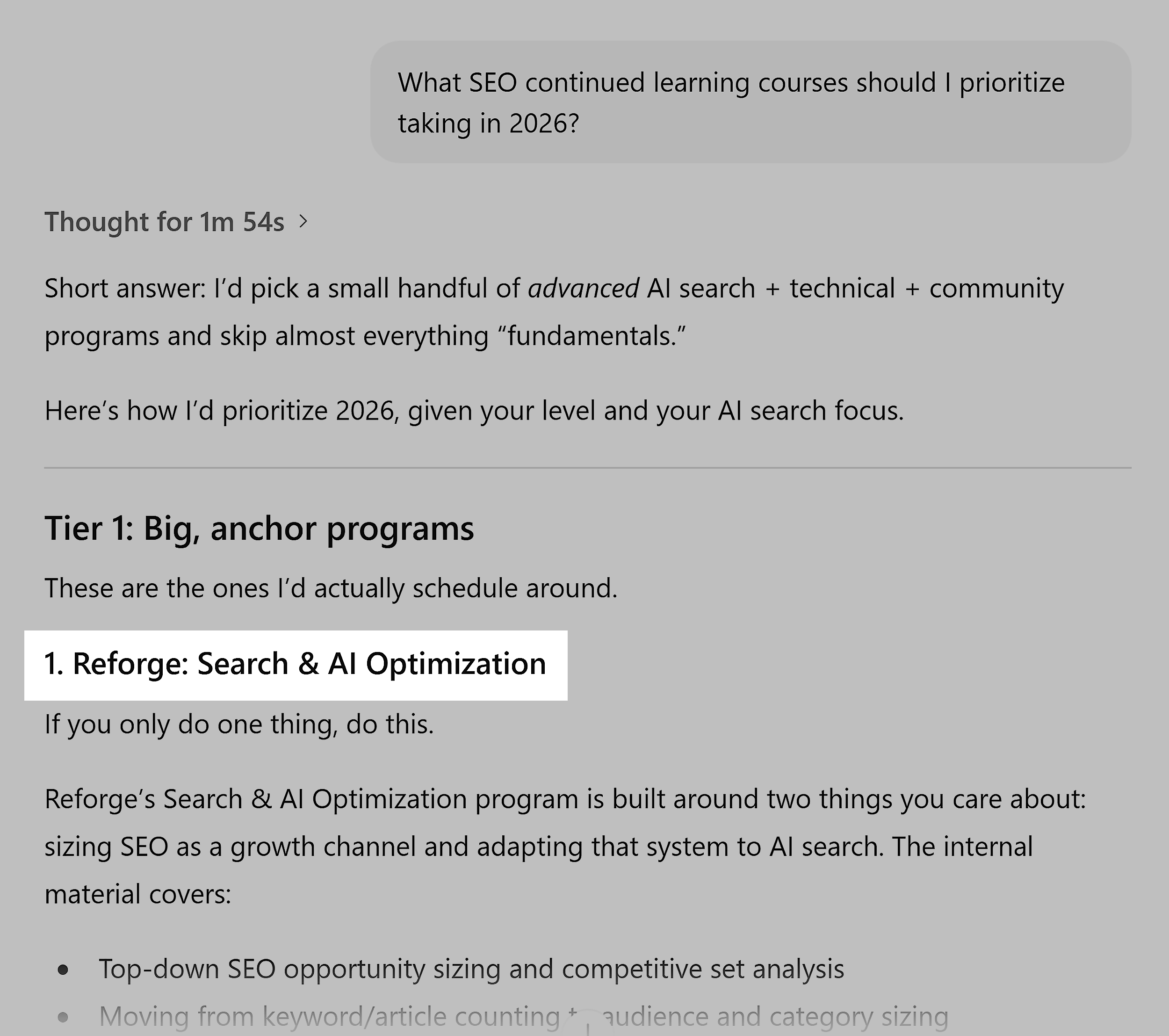
The generic ChatGPT answer, although being more than 800 words, doesn’t mention Reforge once.
This is a great example of how just a question or query isn’t enough information to create the best content for your audience (and why personas still matter).
So the real question is: Who are you trying to help, and what does their world look like?
A content calendar to target keyword intent is very different from a content calendar for a head of revenue at a B2B SaaS company who’s nervous about pipeline.
The second version forces you to think through:
- What that person is trying to solve
- Where they look for answers (search, LLMs, LinkedIn, communities, YouTube)
- How their questions shift over time
A persona-driven strategy also lines up your work across channels. The same core message can guide your SEO pages, LLM-ready explainers, community posts, and email sequences, instead of each channel chasing its own set of keywords.
How this changes your strategy: Keep using intent, but treat it as a supporting detail, not the starting point. Start with 3–5 clear personas, list their real problems and workflows, then map search topics, prompts, and content ideas to those people. Build your reporting around “Did we help this persona move forward?” instead of just “Did this keyword get more traffic?”
5. Traffic KPIs are Replaced by Visibility KPIs
Even though traffic used to be the most important marketing metric for many programs, it’s only ever shown one part of the picture.
The truth is: You can influence a lot of buying decisions without ever getting the click.
AI Overviews, rich snippets, comparison carousels, review sites, Reddit threads, YouTube videos, and LLM answers all shape what people think of you before they touch your site. If you’re only measuring who arrives, you miss most of where the action happens.
Just look at what someone sees in Google when they search “best windbreaker brands.”
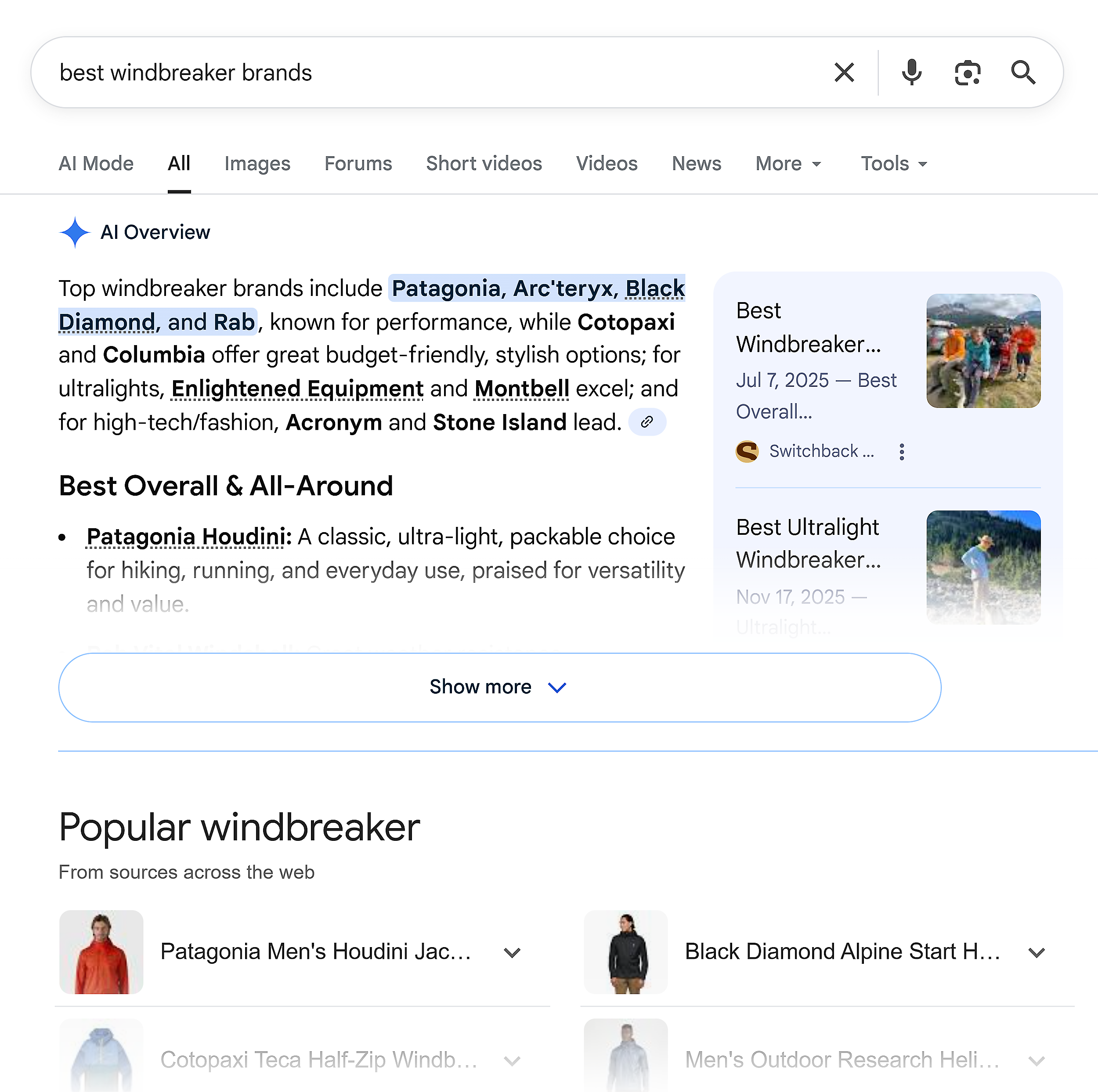
They get an AI Overview that covers some of the top brands right off the bat, so if your brand isn’t featured here, that’s a huge loss.
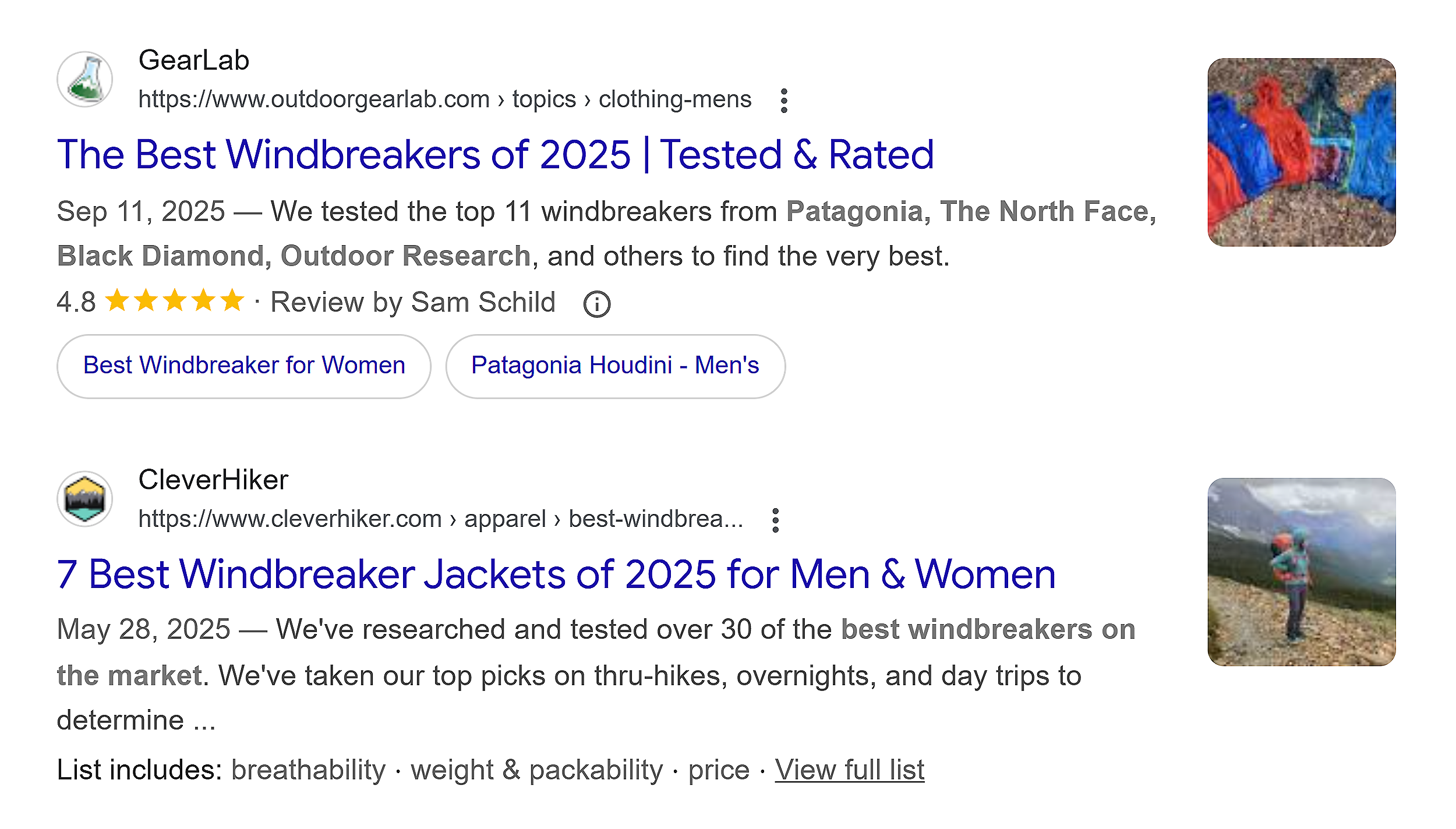
Then you get third-party rankings and reviews, which again, if your brand isn’t mentioned here, that’s a severe disadvantage.
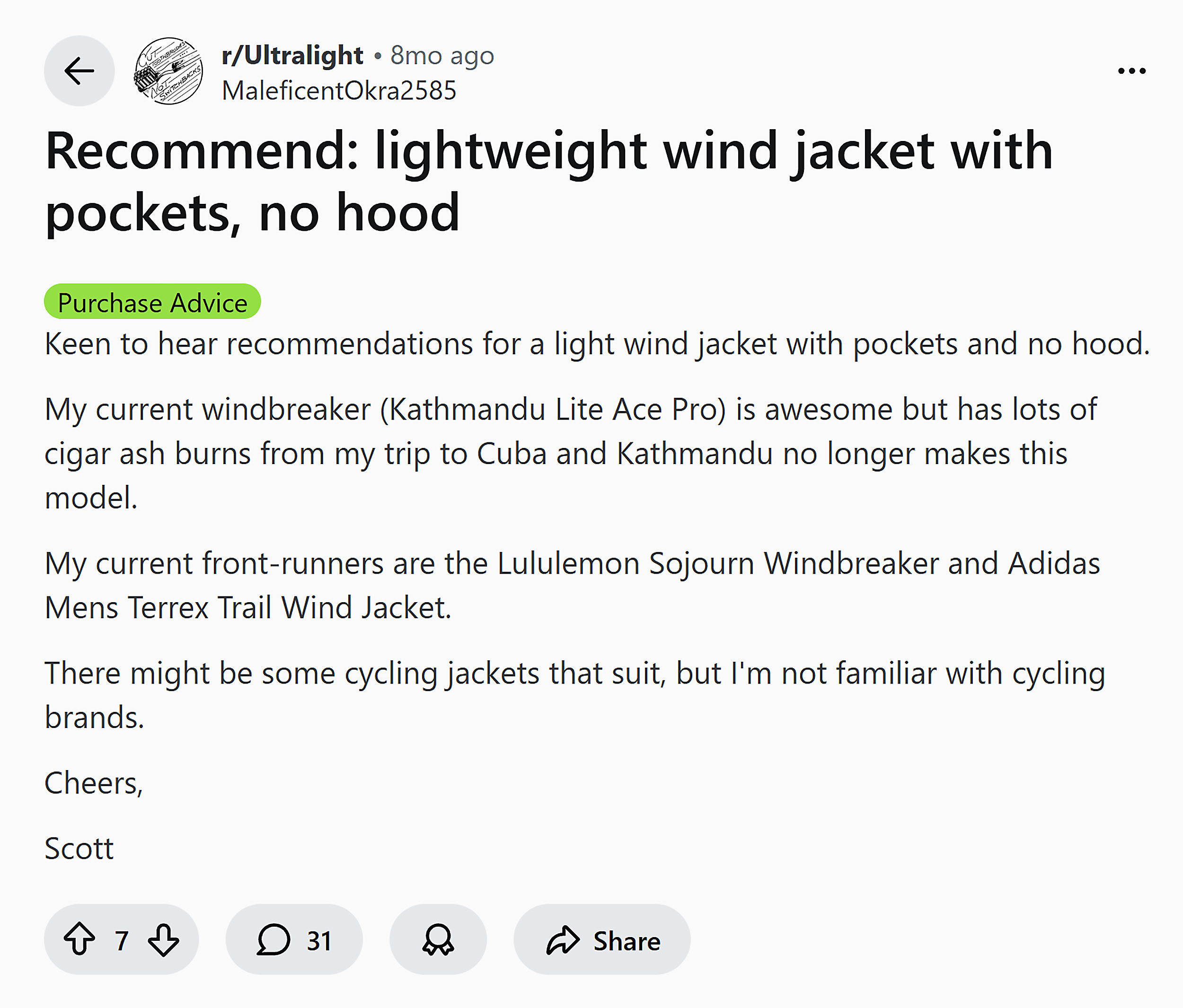
And then you get Reddit threads, where if your brand isn’t part of these organic conversations, that’s a third place you’re falling behind. (Also, note the specificity of the Reddit post — another example of why niche content matters.)
This is why visibility and Share of Voice are becoming the new north star. You need to know:
- How often your brand shows up when people ask questions online
- Where you appear compared to competitors
- Whether your mentions are positive, neutral, or negative
This is true across classic search and AI search. Maybe your traffic from “best bookkeeping software” is flat, but your brand starts appearing consistently in AI Overviews, ChatGPT answers, and comparison articles for that topic.
That visibility still moves pipeline, even if the click path is messy.
It also reflects how people actually buy. They bounce between TikTok, Reddit, Google, ChatGPT, YouTube, and text threads with friends.
The journey is non-linear, so the goal is to be present, credible, and consistent every time they go looking, not just to win the last click.
How this changes your strategy: Keep tracking traffic, but promote visibility metrics to the main dashboard. That can include search impressions, SERP feature presence, AI share of voice, brand mentions in key third-party sites, and sentiment in LLM answers. Tie those visibility gains to downstream metrics like signups, demo requests, and revenue, so SEO is judged by total influence, not just visits.
Winning SEO in 2026
People say the fundamentals of SEO still apply today.
But it depends on what you mean by fundamentals.
If you mean hyper-focusing on keywords and traffic, eh, not so much.
But if you mean relentlessly trying to create the best content and reach your audience where they’re at, then yes, the fundamentals still apply.
You just have to tweak your perspective to adapt to changes in search behavior.
But we’ve always been adaptable, haven’t we? So let’s do this.
Backlinko is owned by Semrush. We’re still obsessed with bringing you world-class SEO insights, backed by hands-on experience. Unless otherwise noted, this content was written by either an employee or paid contractor of Semrush Inc.
